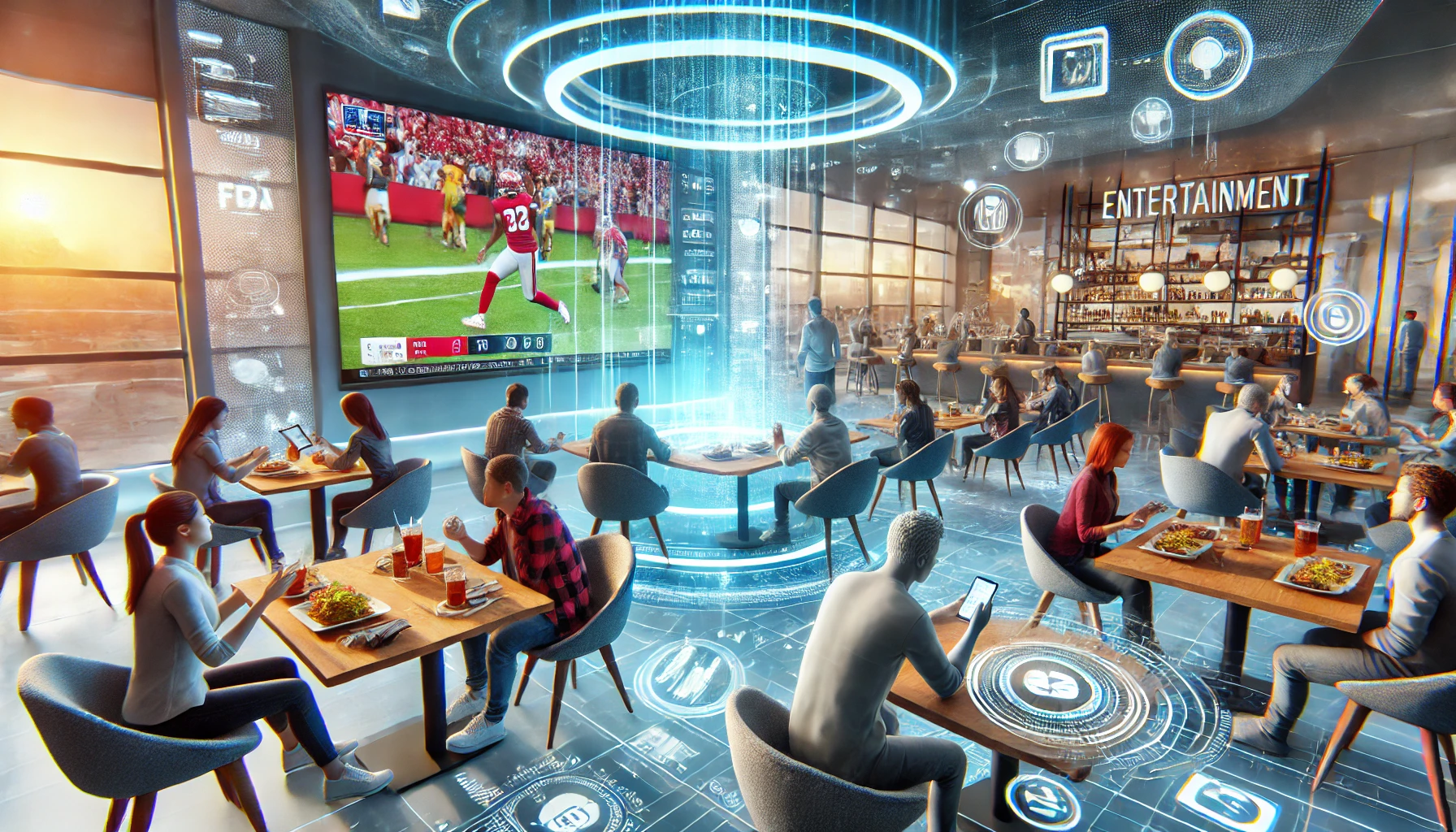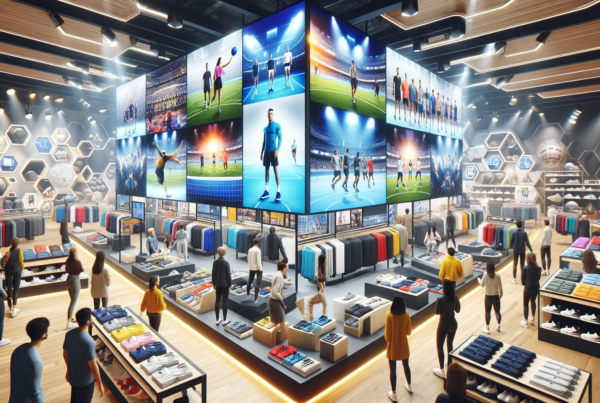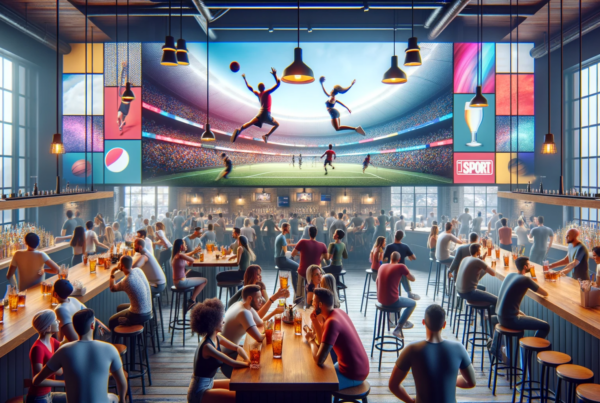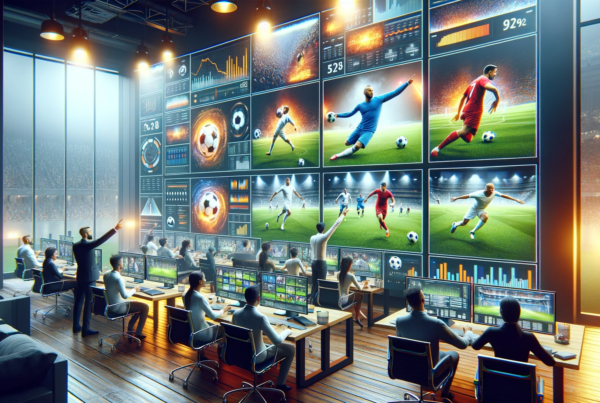Imagine walking into your favorite restaurant, and as you sit down, the TV near your table starts playing your favorite sports highlights. This isn’t a coincidence; it’s the power of personalized entertainment at work. In today’s competitive market, businesses are constantly seeking innovative ways to enhance the customer experience and foster engagement. One of the most effective strategies is through driving customer engagement with personalized entertainment.
For industries like hospitality, gaming, and even auto dealerships, the ability to deliver tailored content can significantly impact customer satisfaction and loyalty. Sports Direct, a leader in providing commercial video programming solutions, understands this dynamic. Their mission is to equip businesses with the tools needed to create unforgettable experiences for their patrons.
Why is personalized entertainment so crucial? Customers today expect more than just a product or service; they crave experiences that resonate with their preferences and interests. According to a study by Accenture, 91% of consumers are more likely to shop with brands that provide relevant offers and recommendations. By leveraging data insights and advanced technologies, businesses can curate content that not only entertains but also engages their audience on a deeper level.
In this blog post, we will explore various strategies to drive customer engagement through personalized entertainment. From understanding your audience’s preferences to implementing the right technologies, we will cover key aspects that can help you create a more engaging and memorable customer experience. Whether you are in the hospitality industry, running a casino, or managing an auto dealership, these insights will guide you in leveraging personalized entertainment to its fullest potential.
Ready to dive in? Let’s explore how you can transform your customer engagement strategy with personalized entertainment.
The Importance of Personalized Entertainment in Customer Engagement
In today’s fast-paced digital landscape, personalized entertainment has emerged as a pivotal strategy for enhancing customer engagement. By tailoring content to individual preferences, businesses can create meaningful interactions that drive customer loyalty and satisfaction. This approach is not only beneficial for customers but also offers significant advantages for businesses across various industries, including hospitality, gaming, automotive, and private offices.
Personalized entertainment leverages data-driven insights to deliver content that resonates with the unique tastes and preferences of each customer. This strategy has proven to be highly effective in retaining customers and fostering long-term relationships. Competitors like Forbes emphasize the significance of data-driven personalization in media streaming apps, highlighting the success of platforms like Spotify’s ‘Wrapped’ initiative.
Enhancing Customer Experience
One of the primary benefits of personalized entertainment is its ability to enhance the overall customer experience. By offering content that aligns with individual preferences, businesses can create a more immersive and enjoyable experience for their customers. This not only increases customer satisfaction but also encourages repeat visits and longer engagement times.
For example, curated playlists or recommendations based on user behavior can significantly improve the user experience. Spotify’s ‘Wrapped’ initiative, which provides users with a personalized summary of their listening habits, has been highly successful in engaging users and encouraging them to share their experiences on social media. This not only enhances the user experience but also serves as a powerful marketing tool.
Driving Customer Loyalty
Personalized entertainment also plays a crucial role in driving customer loyalty. By consistently delivering content that meets the unique needs and preferences of each customer, businesses can build strong, lasting relationships. This is particularly important in industries where customer retention is key to long-term success.
Data-driven personalization allows businesses to understand their customers better and tailor their offerings accordingly. For instance, in the hospitality industry, personalized entertainment options such as customized in-room entertainment systems can significantly enhance the guest experience, leading to higher levels of customer satisfaction and loyalty.
Boosting Engagement Through Data-Driven Insights
Data-driven insights are at the heart of personalized entertainment. By analyzing customer data, businesses can gain valuable insights into their preferences and behaviors, allowing them to deliver more relevant content. This not only boosts engagement but also helps businesses stay ahead of the competition.
For example, streaming platforms like Netflix and Amazon Prime use advanced algorithms to analyze user data and provide personalized content recommendations. This approach has been highly effective in keeping users engaged and encouraging them to explore new content. According to a study by McKinsey, personalized recommendations can increase customer engagement by up to 20%.
Implementing Personalized Entertainment Strategies
Implementing personalized entertainment strategies requires a combination of technology and creativity. Businesses need to leverage advanced analytics and machine learning to analyze customer data and deliver personalized content. Additionally, they need to continuously innovate and experiment with new ways to engage their customers.
Some effective strategies include:
- Curated Content: Create collections of songs, podcasts, films, or TV shows based on themes or notable personalities.
- Data-Driven Campaigns: Use data to create personalized marketing campaigns, such as Spotify’s ‘Wrapped’ initiative.
- Relevant Recommendations: Provide personalized recommendations based on past viewing or listening habits.
- Unique Features: Introduce new features that create buzz and keep users engaged, such as virtual listening or viewing parties.
By implementing these strategies, businesses can create a more engaging and personalized experience for their customers, ultimately driving higher levels of engagement and loyalty.
Conclusion
In conclusion, personalized entertainment is a powerful tool for driving customer engagement. By leveraging data-driven insights and delivering content that resonates with individual preferences, businesses can create meaningful interactions that enhance the customer experience and drive loyalty. As the digital landscape continues to evolve, businesses that embrace personalized entertainment will be well-positioned to succeed in an increasingly competitive market.
Strategies for Implementing Personalized Entertainment
Implementing personalized entertainment requires a strategic approach that leverages technology, data analytics, and customer feedback. Competitors emphasize the importance of integrating personalization into the overall customer experience to drive engagement. Below, we outline effective strategies for implementing personalized entertainment to enhance customer engagement.
Utilizing AI and Machine Learning
Artificial Intelligence (AI) and Machine Learning (ML) play a crucial role in delivering personalized entertainment. These technologies analyze vast amounts of data to identify patterns and preferences, enabling businesses to offer tailored content.
For example, streaming platforms like Netflix and Spotify use AI algorithms to recommend shows, movies, and music based on users’ past behavior. This not only enhances the user experience but also keeps customers engaged for longer periods.
Customer Segmentation
Customer segmentation involves dividing a customer base into distinct groups based on specific criteria such as demographics, behavior, or preferences. This allows businesses to deliver more targeted and relevant content.
By understanding the unique needs and preferences of different segments, businesses can create customized entertainment experiences. For instance, a hotel might offer different in-room entertainment options for families, business travelers, and couples.
Feedback Loops
Incorporating feedback loops is essential for continuously improving personalized entertainment offerings. By collecting and analyzing customer feedback, businesses can gain insights into what works and what doesn’t.
Implementing feedback mechanisms such as surveys, reviews, and direct feedback channels allows businesses to refine their content and services. This iterative process ensures that the entertainment provided remains relevant and engaging.
Data-Driven Campaigns
Data-driven marketing campaigns are highly effective in promoting personalized entertainment. By leveraging customer data, businesses can create targeted campaigns that resonate with individual preferences.
For example, Spotify’s ‘Wrapped’ campaign uses user data to create personalized summaries of listening habits, encouraging users to share their experiences on social media. This not only drives engagement but also serves as a powerful marketing tool.
Relevant Recommendations
Providing relevant recommendations is a cornerstone of personalized entertainment. By analyzing past behavior, businesses can suggest content that aligns with individual tastes.
Streaming services like Amazon Prime and Hulu use advanced algorithms to offer personalized content recommendations. According to McKinsey, personalized recommendations can increase customer engagement by up to 20%.
Innovative Features
Introducing innovative features can create buzz and keep users engaged. Features such as virtual listening or viewing parties, curated playlists, and exclusive content can significantly enhance the user experience.
For example, virtual viewing parties allow users to watch content simultaneously with friends, creating a shared experience that fosters engagement and loyalty.
Continuous Innovation
Continuous innovation is key to staying ahead in the competitive landscape of personalized entertainment. Businesses must constantly explore new ways to engage their customers and keep their offerings fresh.
This could involve experimenting with new content formats, leveraging emerging technologies, or exploring new channels for content delivery. By staying innovative, businesses can maintain high levels of customer engagement and satisfaction.
In conclusion, implementing personalized entertainment strategies requires a combination of technology, data analytics, and customer-centric approaches. By utilizing AI and ML, segmenting customers, incorporating feedback loops, and continuously innovating, businesses can create engaging and personalized experiences that drive customer loyalty and satisfaction. For more insights on enhancing customer engagement, explore our other articles on Sports Direct.
Challenges and Solutions in Personalizing Entertainment
While personalized entertainment offers numerous benefits, it also presents challenges such as data privacy concerns, technological limitations, and the need for continuous improvement. Competitors highlight common challenges and propose solutions to overcome them.
Data Privacy Concerns
One of the most significant challenges in personalizing entertainment is ensuring data privacy. With the increasing amount of data collected from users, companies must navigate complex regulations and maintain customer trust.
For example, the General Data Protection Regulation (GDPR) in Europe imposes strict rules on data collection and usage. Companies must ensure that they are compliant with such regulations to avoid hefty fines and damage to their reputation.
To address data privacy concerns, businesses can implement robust data protection measures, such as encryption and anonymization. Additionally, they should be transparent about their data collection practices and give users control over their personal information.
Technological Limitations
Another challenge in personalizing entertainment is the technological limitations that can hinder the delivery of tailored content. Advanced algorithms and machine learning models are required to analyze vast amounts of data and provide accurate recommendations.
However, not all businesses have the resources to invest in such technologies. Smaller companies may struggle to keep up with the rapid advancements in AI and machine learning, making it difficult to compete with larger players.
To overcome technological limitations, businesses can partner with technology providers or invest in scalable solutions that grow with their needs. Leveraging cloud-based platforms can also help reduce costs and improve efficiency.
Continuous Improvement
Personalized entertainment requires continuous improvement to remain relevant and engaging. User preferences and behaviors are constantly evolving, and businesses must adapt to these changes to keep their audience engaged.
For example, streaming platforms like Netflix and Spotify regularly update their algorithms to reflect changing user preferences. This ensures that their recommendations remain accurate and relevant, keeping users engaged for longer periods.
Businesses can implement feedback loops to gather insights from users and refine their personalization strategies. Regularly updating content and features based on user feedback can help maintain high levels of engagement and satisfaction.
Balancing Personalization and User Experience
While personalization can enhance the user experience, it can also become intrusive if not done correctly. Overly aggressive personalization tactics, such as excessive notifications or irrelevant recommendations, can lead to user frustration and disengagement.
Businesses must strike a balance between personalization and user experience. This involves understanding user preferences and delivering personalized content in a non-intrusive manner. For example, offering personalized recommendations within the app rather than through push notifications can be less disruptive.
Additionally, giving users the option to customize their personalization settings can help improve their experience. Allowing users to control the frequency and type of recommendations they receive can lead to higher satisfaction and engagement.
Ensuring Content Diversity
Another challenge in personalizing entertainment is ensuring content diversity. While personalized recommendations can help users discover new content, they can also create filter bubbles, where users are only exposed to content that aligns with their existing preferences.
This can limit users’ exposure to diverse content and reduce their overall experience. To address this, businesses can implement strategies to promote content diversity. For example, offering a mix of personalized and non-personalized recommendations can help users discover new and diverse content.
Additionally, businesses can use algorithms that prioritize content diversity. For instance, Netflix’s recommendation system includes a diversity metric to ensure that users are exposed to a wide range of content, enhancing their overall experience.
Conclusion
In conclusion, while personalizing entertainment presents several challenges, businesses can overcome them by implementing effective solutions. By addressing data privacy concerns, overcoming technological limitations, continuously improving personalization strategies, balancing personalization with user experience, and ensuring content diversity, businesses can create engaging and personalized experiences that drive customer loyalty and satisfaction. For more insights on enhancing customer engagement, explore our other articles on Sports Direct.
Future Trends in Personalized Entertainment
The future of personalized entertainment is being shaped by emerging technologies and evolving consumer expectations. As businesses strive to enhance customer engagement, understanding these trends is crucial. Competitors discuss various trends such as immersive experiences, augmented reality, and hyper-personalization, which are set to revolutionize the way we consume entertainment.
In this section, we will explore these future trends and their potential impact on driving customer engagement. By leveraging innovative technologies and strategies, businesses can create tailored experiences that resonate with their audience and foster long-term loyalty.
Immersive Experiences
Immersive experiences are at the forefront of personalized entertainment. Technologies such as virtual reality (VR) and augmented reality (AR) offer new ways for users to engage with content. These experiences provide a sense of presence and interaction that traditional media cannot match.
For example, VR can transport users to entirely new worlds, allowing them to explore and interact with their environment in a deeply personal way. AR, on the other hand, overlays digital content onto the real world, enhancing the user’s surroundings with additional information and interactive elements.
According to a report by PwC, the VR and AR market is expected to grow to $1.5 trillion by 2030. This growth presents a significant opportunity for businesses to integrate these technologies into their entertainment offerings, creating unique and engaging experiences that drive customer engagement.
Hyper-Personalization
Hyper-personalization takes personalized entertainment to the next level by leveraging advanced data analytics and machine learning. This approach goes beyond basic recommendations, offering content that is tailored to the individual’s specific preferences, behaviors, and even mood.
Streaming platforms like Netflix and Spotify are already utilizing hyper-personalization to keep users engaged. By analyzing vast amounts of data, these platforms can predict what users want to watch or listen to next with remarkable accuracy. This not only enhances the user experience but also increases the time users spend on the platform.
Businesses can implement hyper-personalization by investing in advanced analytics tools and algorithms. By continuously analyzing user data and refining their personalization strategies, they can deliver content that feels uniquely tailored to each individual, driving higher levels of engagement and satisfaction.
Interactive Content
Interactive content is another trend that is set to transform personalized entertainment. This type of content allows users to actively participate in the narrative, making choices that influence the outcome of the story.
For example, interactive films and TV shows, such as Netflix’s ‘Black Mirror: Bandersnatch,’ allow viewers to make decisions for the characters, leading to multiple possible endings. This level of interactivity creates a more engaging and immersive experience, encouraging users to explore different storylines and share their experiences with others.
Interactive content can be applied across various entertainment mediums, including gaming, music, and live events. By offering users the ability to shape their experience, businesses can create more engaging and memorable interactions that drive customer loyalty.
Voice-Activated Entertainment
Voice-activated technology is becoming increasingly popular in personalized entertainment. Devices like Amazon Echo and Google Home allow users to control their entertainment systems using voice commands, making it easier and more convenient to access content.
Voice-activated assistants can also provide personalized recommendations based on the user’s preferences and listening habits. For example, users can ask their device to play music or suggest movies that match their mood or interests.
As voice-activated technology continues to evolve, businesses can leverage this trend to enhance their personalized entertainment offerings. By integrating voice-activated features into their platforms, they can provide a seamless and intuitive user experience that drives engagement and satisfaction.
Social Integration
Social integration is another trend that is shaping the future of personalized entertainment. By incorporating social features into their platforms, businesses can create a more connected and interactive experience for users.
For example, streaming platforms can allow users to share their favorite content with friends, create collaborative playlists, or participate in virtual viewing parties. These social features not only enhance the user experience but also encourage users to spend more time on the platform and engage with their social networks.
According to a study by Nielsen, 84% of people trust recommendations from friends and family over other forms of advertising. By integrating social features into their personalized entertainment offerings, businesses can leverage the power of social influence to drive engagement and attract new users.
Conclusion
In conclusion, the future of personalized entertainment is being shaped by emerging technologies and changing consumer expectations. By embracing trends such as immersive experiences, hyper-personalization, interactive content, voice-activated entertainment, and social integration, businesses can create tailored experiences that resonate with their audience and drive customer engagement.
As the digital landscape continues to evolve, businesses that stay ahead of these trends will be well-positioned to succeed in an increasingly competitive market. For more insights on enhancing customer engagement, explore our other articles on Sports Direct.
Maximizing Engagement through Personalized Entertainment
As we have explored, personalized entertainment is a powerful strategy for driving customer engagement. By leveraging data-driven insights, businesses can deliver content that resonates with individual preferences, creating meaningful interactions that enhance customer satisfaction and loyalty. From the hospitality industry to gaming and automotive sectors, the impact of personalized experiences is undeniable.
One of the key takeaways is the importance of understanding your audience’s preferences. Utilizing AI and machine learning, businesses can analyze customer data to offer tailored content that aligns with their interests. This not only boosts engagement but also fosters long-term relationships. For example, curated playlists and personalized recommendations have proven to be effective in retaining customers and encouraging repeat visits.
Moreover, implementing feedback loops is crucial for continuous improvement. By collecting and analyzing customer feedback, businesses can refine their personalization strategies and ensure that the content remains relevant and engaging. This iterative process helps in maintaining high levels of customer satisfaction.
Looking ahead, future trends such as immersive experiences, hyper-personalization, and interactive content are set to revolutionize personalized entertainment. Technologies like virtual reality (VR) and augmented reality (AR) offer new ways for users to engage with content, providing a sense of presence and interaction that traditional media cannot match. Embracing these trends will enable businesses to create unique and engaging experiences that drive customer loyalty.
To sum up, personalized entertainment is not just a trend but a necessity in today’s competitive market. Businesses that embrace this strategy will be well-positioned to succeed. We encourage you to explore more insights and strategies on enhancing customer engagement by visiting Sports Direct.
Key Takeaways:
- Utilize AI and machine learning to analyze customer data and offer tailored content.
- Implement feedback loops to continuously improve personalization strategies.
- Embrace future trends such as immersive experiences and hyper-personalization.
- Create engaging and meaningful interactions that drive customer loyalty.
For more insights, explore our other articles on Sports Direct and stay ahead in driving customer engagement with personalized entertainment.








